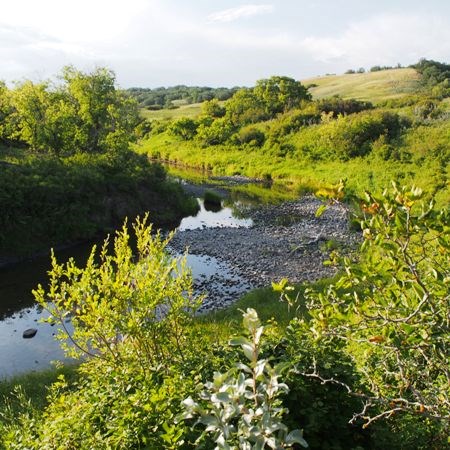Pipestone Creek, Saskatchewan ‑ The protection of grasslands and wetlands is a priority in Saskatchewan and not-for-profit organizations Ducks Unlimited Canada and the Nature Conservancy of Canada are working together to conserve a natural area.
The property is in southeast Saskatchewan, located along Pipestone Creek in the Moose Mountain Natural Area. The private landowners, Clint and Jody Blyth,worked with both DUC and NCC to develop conservation agreements to protect existing grassland and wetland areas.
“We are very pleased to have the opportunity to participate in the conservation easement program with DUC and NCC,” say the Blyths.
“As our surrounding landscape is rapidly being converted from parkland to dry land prairie cropland the need to preserve larger areas of permanent cover is becoming more urgent.”
NCC’s Pipestone Creek project consists of 1,124 acres of tame and native grasslands mixed with bur oak aspen parkland habitat. Grasslands are one of the most endangered ecosystems in the world and help filter water and store carbon. They also provide habitat for wildlife listed under Canada’s Species at Risk Act, including bobolink (threatened), Sprague’s pipit (threatened), loggerhead shrike (threatened), little brown myotis (endangered) and northern leopard frog (special concern). The location of the property within the Pipestone Creek valley makes it important in conserving habitat connectivity in an area with high levels of threat to habitat fragmentation.
“There are many wonderful things to enjoy on and around the property we steward. There are burr oak trees close to 200 years old that were here before homesteaders moved into this area. Natural plum groves can be found in the valley, along with a long list of native plants and grasses,” the Blyths explain.
“Several sharp-tailed grouse leks are present on the uplands which always provide us entertainment spring and fall. In the valley, mink, fisher, painted turtles, snapping turtles and wood ducks and, more recently, river otter can be seen if you are patient and quiet. Several archaeological sites have also been documented on this property and will be protected in perpetuity.”
In addition to the land conserved by NCC, DUC’s Blyth Conservation Easement has resulted in the protection of an additional 1,907 acres of tame grasslands, wetlands and mixed natural lands. Located in an area of significant habitat value for waterfowl and wildlife — and one at risk of further habitat degradation and loss — the project will serve to protect these lands for the long term.
“It is thanks to the Blyth family’s conservation ethic, foresight and commitment that this intact parcel along the Pipestone Creek has been permanently preserved for its value to wildlife and people,” says Andrew Hak, head of Conservation Programs, Ducks Unlimited Canada, Saskatchewan.
“Conserving these grasslands and wetlands is important for our health and the at-risk species that live there,” says Anja Sorensen, program director for the Nature Conservancy of Canada’s Saskatchewan Region.
“Many plants and animals rely on connected habitat to move around, find mates, hunt, forage and reproduce. Movement between significant areas of habitat, such as the area found at Pipestone Creek, is critical for maintaining healthy populations of species.”
To supportthe Nature Conservancy of Canada’s work in Saskatchewan to protect endangered grasslands, wetlands and the at-risk species that live here. Visit conservegrasslands.ca.




